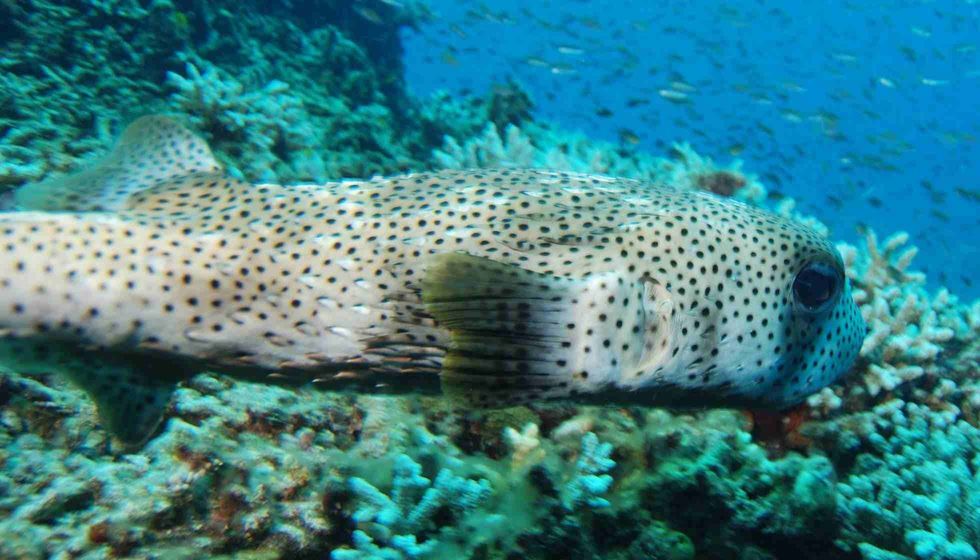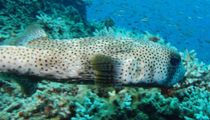Porcupine fish, commonly known as balloonfish, blowfish, or globefish, is a medium to large-sized fish that belongs to family diodontidae and order tetraodontiformes. The porcupine fish scientific name is Diodon hystrix.
They usually inhabit shallow temperate and tropical seas around the world and live in large schools of thousands of porcupine fishes. These fishes are greyish-tanned colored and are uniformly covered with small, black specks.
They have a white underbelly and sharp spines which are basically scales that have been modified into spines to protect the fish from predators. Certain species of this fish are poisonous, containing tetrodotoxin in their liver and ovaries.
These fishes usually move slowly and have the ability to inflate themselves by filling their bodies with water or air. This is also a defence mechanism that allows them to avoid falling prey to sea creatures with bigger mouths.
While in the inflated state, their spikes radiate outwards. Owing to these defences, these fishes do not have too many predators, however, killer whales and sharks might sometimes prey on them.
Porcupine fish are apparently a delicacy in Cebu, the Philippines, where they are eaten as exotic seafood. Continue reading below to find out more interesting facts about these fishes. If you like this article, then be sure to check out our articles on hogfish and candiru.
Porcupine Fish Interesting Facts
What type of animal is a porcupine fish?
Porcupinefish, commonly known as blowfish or globefish, is a medium-large-sized fish belonging to the Diodontidae family and Tetraodontiformes order. They are usually found in tropical and shallow temperate seas around the world.
What class of animal does a porcupine fish belong to?
Porcupinefish belongs to the class of ray-finned fishes.
How many porcupine fish are there in the world?
The exact number of porcupine fishes is unknown. However, there are many subspecies of porcupine fish.
Where does a porcupine fish live?
Porcupinefishes live in large schools with thousands of fishes of their species. They tend to live around shallow open reefs with soft bottoms. They live around rocky or muddy substrata and sometimes even on coral reefs.
What is a porcupine fish's habitat?
The porcupine fish habitat usually constitutes the tropical and shallow seas around the world. They are found in the Mediterranean Sea, eastern Pacific regions covering San Diego, California in the United States to Chile including the Ecuador Islands, the western Atlantics covering regions of Massachusetts, Gulf of Mexico, and Brazil.
Who do porcupine fish live with?
Porcupine fishes live in large schools which contain thousands of their fish species.
How long does a porcupine fish live?
Porcupine fishes usually live for about 12-15 years.
How do they reproduce?
Porcupine fishes usually breed once every year during the breeding season from May to August. These fishes are broadcast spawners. They spawn towards the surface of the water where the eggs float until they hatch after four days.
What is their conservation status?
They are in the Least Concern category in the IUCN Red List. However, the conservation status for some of the subspecies of the same genus is unknown.
Porcupine Fish Fun Facts
What do porcupine fish look like?

Porcupinefishes are greyish-tanned colored and are uniformly covered with small, black specks with a short, broad body and large eyes and thick lips. They have a white underbelly and sharp spines which are basically scales that have been modified into spines to protect these fish from predators.
How cute are they?
Some porcupinefishes can be extremely cute. The character of Bloat in the animated films 'Finding Nemo' and 'Finding Dory' is a porcupine fish.
How do they communicate?
Porcupinefishes communicate the same way as other fishes do. They use smell, sound, and impulse, among other things, to achieve communication with each other and call their mates for spawning.
How big is a porcupine fish?
Porcupinefishes can reach up to a maximum length of 3 feet or 90 cm, however, the average length is around 1.3 to 2 feet or 40 cm. They can become thrice their size by inflating their bodies with water or air.
How fast can a porcupine fish swim?
The exact speed at which a porcupine fish can swim is not known. However, they are known to be slow movers. While they are in their inflated state, they are still able to swim well, though they swim upside down as a result of the altered buoyancy.
How much does a porcupine fish weigh?
The maximum recorded weight of a porcupinefish is 2.8 kg or 6.17 lb. The average size varies from 4-6 lb.
What are their male and female names of the species?
There is no distinct name for the males and females of this particular species. They simply referred to as the male porcupinefish or the female porcupinefish.
What would you call a baby porcupine fish?
There is no special name for baby porcupinefishes. However, all baby fish are called fry, hence a baby porcupine fish, too, can be called a fry.
What do they eat?
They have strong jaws with sharp teeth which are fused together, which allows them to be able to crush and grind hard shells. They eat sea urchins, crabs, snails, and other hard-shelled sea creatures with ease.
Their rubbery, large lips protect them from getting hurt from the shells or broken spines of these creatures that they eat. Porcupinefishes are carnivorous and durophagous. In fact, all invertebrates in the ocean are seen as food for these porcupinefishes.
Are they poisonous?
Not all porcupinefishes are poisonous though some of their species certainly are. They contain tetrodotoxin in their liver and ovaries which is formed from the bacteria present in the food that they eat. Porcupine fish poison is roughly 1200 times more potent than cyanide. There is enough poison in one fish to kill 30 adult humans in one go.
Would they make a good pet?
They can be kept as pets as they are pretty sturdy creatures and do not need a lot of care. Though, one has to be very careful about what other creatures they are keeping with the porcupinefishes.
Porcupinefishes are known to be pretty common in the aquarium trade. Porcupine puffer fish tank mates include tangs, eels, foxfish, and angels. Porcupine puffer fish compatability mainly lies with large clownfish, hawkfish, and wrasses.
Porcupine puffer fish care is pretty hassle-free. They are sturdy creatures that can be kept in acquariums and do not need too much looking after.
Did you know...
Porcupine fish skeleton is sometimes sold to tourists as souvenirs.
Porcupinefish and pufferfish are not the same even though they are closely related and both belong to the order tetraodontiformes. All pufferfishes might not have large spines which the porcupinefishes have.
Porcupine fish size can vary depending on which subspecies it belongs to. The Australian porcupine fish is one of the smallest sub-species of this family diodontidae.
Porcupinefishes can be touched, however, like most other creatures, they do not like to be touched or petted. Trying to pet them or touch them might irritate or scare them which might lead them to bite you.
What does a porcupine fish do to protect itself?
Porcupinefishes have the ability to inflate and blow up to a greater proportion by swallowing large quantities of either water or air. This allows the fish to grow to almost three times their normal size, thereby making it impossible for many predators to hunt them.
They also have long spines which radiate outwards when they are inflated. Apart from these two defences, a lot of the porcupinefishes are also poisonous. Thus, owing to these factors they do not have too many predators.
What happens when a porcupine fish puffs up?
The porcupinefish can inflate its body with air or water and upon doing so it becomes thrice its normal size. They also start radiating their long spines outwards towards any sea creatures which might try to attack them.
This is a defence technique used by them to avoid falling prey to animals with a mouth size that is bigger than their normal body size.
Here at Kidadl, we have carefully created lots of interesting family-friendly animal facts for everyone to discover! Learn more about some other fish including brain coral, or barb.
You can even occupy yourself at home by drawing one on our Porcupine fish coloring page.










